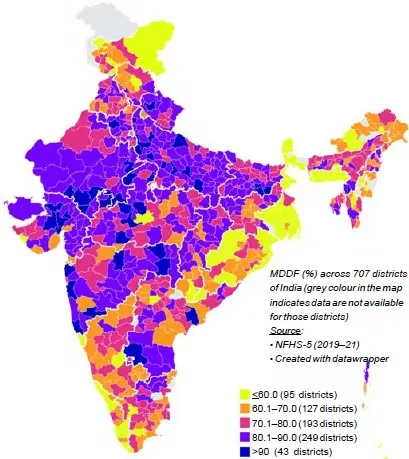Syllabus :GS 2/Health
In News
- The report was published in the National Medical Journal of India published by All India Institute of Medical Sciences.
Minimum diet diversity
- Minimum dietary diversity is a reliable and widely used indicator approved by the World Health Organization (WHO) that reflects the access and consumption of diverse food groups and essential micronutrient availability to the children.
- As per the WHO, nutrition-related factors lead to approximately 35 percent of child deaths and contribute to 11 per cent of the total disease burden globally.
Read more: UN Statistical Commission adopts a new indicator on Minimum Dietary Diversity
Key Findings of recent report
- Data sources : Scientists used National Family and Health Survey (NFHS) datasets from rounds 3, 4 and 5 to examine MDDF among children longitudinally, regionally and across population groups having diverse background characteristics.
- The NFHS surveys, under the Ministry of Health and Family Welfare, provided representative data covering India. The MDDF rate declined from 87.4% in NFHS-3 (2005-06) to 77.1% in NFHS-5 (2019-21).
- Prevalence of MDDF: Despite a decline, eight Indian states, mainly in the north, central, and west, still have over 80% MDDF among children aged 6-23 months.

- Uttar Pradesh (86.1%), Rajasthan (85.1%), Gujarat (84%), Maharashtra (81.9%), and Madhya Pradesh (81.6%) are the highest.
- Regional Trends: Central India had the highest MDDF (84.6%) as of 2019-21. Only 95 of the 707 districts analyzed showed MDDF prevalence below 60%, mainly in the south, east, northeast, and north.
- Diet Diversity: Consumption of food items within eight groups, including eggs, Vitamin A-rich foods, vegetables, and flesh foods, increased from NFHS-3 to NFHS-5.
- Factors Affecting MDDF: Logistic modeling found higher MDDF among children of young, illiterate mothers, girls, poor households, anemic children, low birth-weight infants, and those lacking regular health checkups at anganwadis/ICDS centers.
Recommendations
- The study emphasizes the need for intensive policy interventions in nutrition resource deliverance, beneficiary population counselling for screening of malnutrition and diet consumption and strengthening of local self-governance systems for programme implementation.
- Programs like Poshan Abhiyaan and ICDS are active but require stronger convergence to meet gaps in nutritional resources.
Source: DTE
Previous article
India-Germany: MoUs on Green Hydrogen, Technology & Trade
Next article
United Nations Day